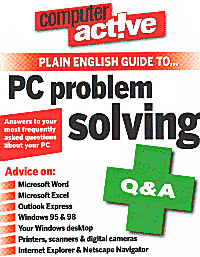

Hardware |
||
|
Personal Computer |
|
|
Peripherals |
|
|
Image Processing |
|
Windows 95/98 |
||
|
The Basics |
|
|
Desktop |
|
|
Files and Folders |
|
Software |
||
|
Word processors |
|
|
Spreadsheets |
|
|
General Software |
|
Internet |
||
|
|
|
|
The Web |
|
|
General Internet |
|
Jargon Buster |
||
|
Jargon Buster | |
 HARDWARE
HARDWARE
Replacing your PC's battery
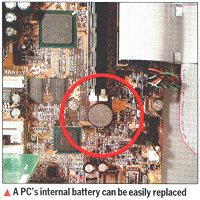 Q.
I have been using my computer for many years and noticed
that the Windows clock at the bottom right-hand corner of the screen has
started running slow. I now have to adjust it every time I start the PC.
Is there anything that can be done to set it right?
Q.
I have been using my computer for many years and noticed
that the Windows clock at the bottom right-hand corner of the screen has
started running slow. I now have to adjust it every time I start the PC.
Is there anything that can be done to set it right?
A. It sounds as though your
computer's battery may need replacing. Your computer uses this battery when
it's switched off to keep track of things like the time. If you're confident
about lifting the lid off your PC, you can replace it yourself As always,
turn off the computer and ground yourself by touching something metal that's
connected to the earth, such as a radiator, before removing the computer's
plug from the wall socket. Take the cover off your PC. You should be able
to spot the battery quite easily. It is round and silver rather like a watch
battery only larger. Replacement batteries can be found at your local PC
retailer - and if you're in doubt, most places will fit a new one for you,
though they may charge you for the labour.
Switching the PC off
Q. Some people
say you should never turn your computer off, as you risk damaging the components
inside because they heat up when it's running and cool down again when the
computer is switched off. Is this right or can I shut it down when I've finished
with it?
A. There was a time when
PC chips were considered unstable enough to be incapable of handling the
constant heating up and cooling down of a day switched on and a night switched
off. Nowadays, this really isn't a problem and all modern PCs can be switched
off without any worries.
Permanently cleaning the hard disk
Q. I recently read an article that seemed to be saying
that those of us who have succumbed to the temptation of viewing pornographic
sites risk facing prosecution. It went on to say that the only way to remove
the evidence of this is to physically destroy the computer, because forensic
experts can find it no matter what one does. Is this true?
A. Putting aside the moral issues of pornography, this question highlights the way that confidential information may remain on your hard disk even though you think you have deleted it. This is because when data is deleted, Windows may just mark an area of your hard disk as free, but not erase it until new data is recorded over it. In some cases data can survive even if a disk has been re-formatted. With the right software, snoopers may be able to recover some of the deleted Information. Ever when new data has been written to the disk, it is theoretically possible to use special equipment to tell what was there before.
Playing CDs through the speakers
Q. On my old PC I used to be able to play audio
CDs through the speakers. I have now bought a brand new PC, but when I play
a CD I have to plug headphones into the front of the drive in order to hear
it. What is wrong?
A.The problem is that your CD-ROM drive isn't connected to your sound card. This is a simple case of fitting the correct wire, and is an easy process as long as you have the documentation for both the CD-ROM drive and the sound card. If you no longer have this to hand, get in touch with the manufacturer of your new PC and ask them for the information and a cable.
DVD regions
Q. I've recently purchased a PC with a DVD player.
I set this up to play region 1 discs so that it could play DVD movies from
the US. I've since built up a healthy collection of titles, all from region
1. However, I have a single region 2 disc that I got with the computer. I'd
like to know if there's any way I can set up the PC to play DVDs from both
regions.
A. Region 1 players
are designed to play films in America, while region 2 players are designed
for the UK market. Because the drives are essentially the same for each region,
the manufacturers of DVD drives for PCs tend to make these all the same,
with the ability to let the user set the region themselves.
This means you can choose to either set it for the region in which you live,
or to one of the other DVD regions. You can change your mind up to five times
(depending on the drive). After this, however, you'll have to live with your
final choice.
Using a modem away from home
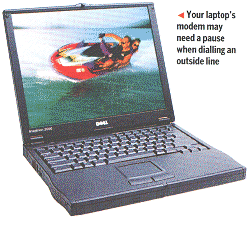 Q. I use a laptop computer and modem
to access the internet as I travel round the country. However, I find it
very frustrating that I rarely get an outside line and it is necessary for
me to input a pre-dial number into the modem, which never seems to work
properly.
Q. I use a laptop computer and modem
to access the internet as I travel round the country. However, I find it
very frustrating that I rarely get an outside line and it is necessary for
me to input a pre-dial number into the modem, which never seems to work
properly.
A.You need to insert
commas after the pre-dial number to make the modem wait while the switchboard
connects to an outside line. This is often required when dialling out of
an internal switchboard. The length of time it has to wait depends on the
switchboard. Start off by putting one comma in, and if that doesn't work,
keep adding another one until it works.
The other option could be to access the internet through a mobile phone.
This can be slow, so don't try browsing graphically intensive websites, but
it should be good enough for collecting your email. Some PC Card modems can
be made to work with a suitable mobile phone - check your manual for details
or you can buy a phone with a modem already built in.
![]()
Modem speeds
Q. I have a 56Kbps modem but it never seems to exceed
download speeds of 31Kbps. Is it my modem, my phone line or my ISP that is
the problem?
A. What you have to remember
is that 56Kbps is the absolute maximum possible speed that one of these modems
can connect at in perfect conditions. How fast it actually works depends
on your modem, the version of the modem's internal software, the quality
of your phone line, how busy your ISP is and how busy the internet as a whole
is. By making sure you have the latest software from your
ISP and the latest hardware
upgrade, you can maximise your connection speed, though it still probably
won't exceed the 3lKbps you are achieving now by very much.
If you really want high speeds you may have to consider upgrading your telephone
and Internet connection to a higher speed service, such as ISDN.
Modem volume
 Q.
I have just bought a new modem that works well but is unbearably
noisy when dialling and connecting. Have you any suggestions for muting it?
Q.
I have just bought a new modem that works well but is unbearably
noisy when dialling and connecting. Have you any suggestions for muting it?
A. You should be
able to alter the volume on your modem through its Properties. Call up the
Control Panel via the Start menu and Settings option, then double-click on
the Modems icon. Highlight your modem with a single click of the left mouse
button, and select the Properties button. This should bring a window up with
a Speaker Volume option. There are four settings, ranging from mute to very
loud. If your modem is set very high, you may be happier with a low setting
so you can still hear what's going on at the other end.
Cleaning your mouse
Q.
The pads on the underside of my mouse that help the ball
run freely have worn down, making it run erratically. Do I have to buy a
new mouse?
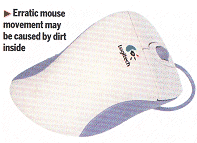
A. It's likely this isn't anything to do with the pads, but simply that the
insides of your mouse have got clogged with dirt. This doesn't mean you've
particularly dirty hands - it happens to most mice eventually, especially
if they are heavily used for controlling games. Inside your mouse there are
two bars which translate the rotation of the ball into the movement of the
cursor arrow on your screen. The ball inside the mouse picks up sweat, dead
skin and grime from your mouse mat and deposits it on these bars. This means
that the ball occasionally loses contact with the rest of the mouse, causing
your cursor to skip around on the screen. You can solve this by removing
the ball from your mouse and cleaning the insides. Turn the mouse upside
down and you will see a removable plate - you can take this off by twisting
it a little anti-clockwise, which will release the ball.
You should then notice the bars and see the dirt on them where the ball connects.
This can usually be removed with a little alcohol (such as white spirit)
on a cloth.
Webcam as stop motion camera
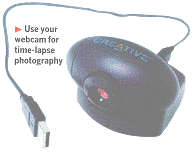 Q. I purchased a webcam and it works
fine, but I've decided I want to make a freeze- frame video showing one of
our plants opening and closing during the day. I would then like to replay
the frames in one continuous film. Is this possible?
Q. I purchased a webcam and it works
fine, but I've decided I want to make a freeze- frame video showing one of
our plants opening and closing during the day. I would then like to replay
the frames in one continuous film. Is this possible?
A. There are many packages designed to film time-lapse sequences, one such
is Gotcha from Prescient Technology (www.gotchanow.com). The program can
be configured to take snapshots at regular intervals as well as detect motion
in front of the camera. Although it's designed to make your PC act as a security
device, it could also be used to help you keep an eye on your plants.
Restoring data from a backup
Q. I lost everything on my hard disk when it
failed recently, but fortunately I had made a full backup on my Iomega Zip
drive. I bought a new hard disk but, because it is blank, I am not sure how
to install my new operating system. Could you please tell me how to set this
up? I have a Windows 98 upgrade and Windows 95, both on CD.
A. Although you have
a full backup, this is only really useful for restoring your data. You are
still going to have to restore your operating system from the original disks.
Start off by digging out the startup disk that your computer manufacturer
should have supplied. This should include drivers for your CD-ROM drive,
so you can boot up the machine and install Windows 95. Then you can install
your Windows 98 upgrade. Next you can reinstall your applications
and games from their original discs. It's best to do it this way rather than
from your backup, as many of them will have installed extra files into your
Windows directory and elsewhere, without which they won't work properly.
Now you can restore your work, such as your My Documents folder, from your original backup.Not only will your system probably work faster because of your new hard disk, but all your applications will have been cleanly installed and you'll probably find your whole PC works better than it ever has.
Recording LPs to CD
Q. Can you tell me how to record my LP records
onto a CD using my new CD writer?
A. There should be
output connections on the back of your LP player, probably labelled Aux
Out Left and Right. They should be standard phono plugs, the cable
for which can be picked up from a hi-fi store for a few quid. You will have
to buy a mini jack adapter to make the other end of the phono leads plug
into the Line In socket on your sound card, but this is all you need
to connect the two together.
You will then need some software, such as Easy CD Creator from Adaptec (around
£65) which includes the Spin Doctor application. This will make it easier
to do the trickier bits such as taking out scratches, clicks and pops.
What type of scanner to buy
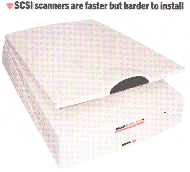 Q. Please could you explain the pros and cons
of installing scanners that require SCSI cards? I am completely confused
as to whether to buy a scanner that uses SCSI or whether to go for a parallel
port model. If I go for SCSI how do I install it?
Q. Please could you explain the pros and cons
of installing scanners that require SCSI cards? I am completely confused
as to whether to buy a scanner that uses SCSI or whether to go for a parallel
port model. If I go for SCSI how do I install it?
A. SCSI
(pronounced 'scuzzy') scanners are generally considered to be better than
parallel port scanners because they are faster and more reliable. You have
to take the lid off your PC though, making them harder to install, and they
tend to be more expensive than parallel port models because they include
that extra piece of equipment - the internal SCSI card. To fit a SCSI card,
remove the casing from your PC and locate a spare expansion slot. This will
be beside other expansion cards in your machine such as the modem, graphics
or sound card. This is not difficult to perform, despite the fact that taking
the lid off can be a bit scary the first time you do it. When you buy your
scanner, whether it's a SCSI or parallel port model, ensure that it comes
with all of the relevant installation manuals to guide you through the
process.
Using a dot matrix printer
Q. I use a
dot matrix printer as
a back up to my inkjet model. I have found and installed the driver but the
printer is painfully slow. It seems to only print the top half of a line,
then pauses for a couple of seconds or so, before going back to the beginning
to print the bottom half of the line. It isn't this slow if I reconnect it
to my old computer from the early eighties. How can that be?
A. Your problem is due to
the sophistication of Windows compared to the software for those old eighties
computers you mentioned. Modern word processing software uses graphical
presentation (called WYSIWYG or, What You See Is What You Get)
so that you can easily print fancy fonts without worrying about how your
printer will interpret them. When your dot matrix printer was made, in the
days before Windows, word processor programs could only print using
the fonts that were built into each printer. In this 'native' mode, dot-matrix
printers such as yours were relatively fast. The problem arrives when
Windows tries to print its own fonts by using them as graphics. Old
printers are slow at printing these.
To get faster printing, try selecting one of the fonts that is built into
the printer. Windows identifies these with a printer icon to left of the
font name (instead of the normal 'TT' symbol). Although printing will be
fast, you'll only be able to print in the font sizes supported by the printer.
Using multiple image capture devices
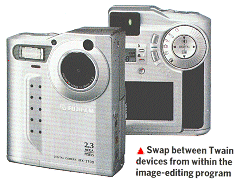 Q.
I have a digital camera and a scanner, both of which use a standard
called Twain to communicate with the computer. I can
use the camera, but can't get the scanner to work.
Q.
I have a digital camera and a scanner, both of which use a standard
called Twain to communicate with the computer. I can
use the camera, but can't get the scanner to work.
A. Most image processors
can handle the swapping of
Twain devices quite easily,
and most work on the same principle.
To start downloading or scanning the image, go to the File menu and choose
the option Acquire, Import or something similar. Your PC will look
for whichever device the default Twain driver relates to - in this case it
will be the camera.
Before you begin scanning, change the Twain source to the device you want
to use.
For example, in Paint Shop Pro, go
to the File menu and click on Select Source. In Adobe
PhotoShop, scroll down to Import and across to Select Twain-32
source. If you're using Imaging (the program that comes with Windows
95 or 98) choose Select Scanner. In the dialogue box that
opens, select the scanner's name and return to the application. You should
then be able to scan as normal.
lnkjet printing delays
Q. Why is there such a long delay between pressing the
Print button and waiting for my inkjet printer to start printing?
A. The delay occurs while
the PC converts your work into a format the printer can understand, and stores
this translation temporarily on the hard disk. This minimises the amount
of time your computer has to spend doing this. The alternative would be to
send the work directly to the printer, but you would have to wait for the
printer to convert and print your pages a bit at a time.
 WINDOWS95/98
WINDOWS95/98
Ensuring Defrag works properly
Q. Windows Defrag gets to about 85 percent then returns
to the beginning. Can you tell me why this happens?
A. You need to switch off
all the programs running in the background by pressing the Ctrl, Alt and
Del keys all at the same time. This is because programs will be changing
the hard disk's contents even though you don't realise they're running. A
window should appear which you can use to close down all the background programs
(using the End Task button). Switch off everything except Explorer.
Also, right-click on your desktop, choose Properties and turn off
your screen saver (click on the Screen Saver tab and make sure the box with
your screen saver name says None). Once all this is done your Disk Defragmenter
should work without interruption.
A Shut down all programs before running
Defrag
Autorun on CD-ROMs
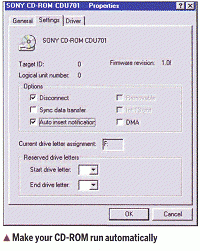 Q. Without Autorun on my PC I am unable to
play many of the CD-ROMs that I have.Can you tell me how to switch it
on?
Q. Without Autorun on my PC I am unable to
play many of the CD-ROMs that I have.Can you tell me how to switch it
on?
A. Autorun should work if
Windows is instructed to use it. To check this, right- click on the My
Computer icon, and select Properties. In the dialogue box that opens,
select the Device Manager tab, and then highlight your CD-ROM drive.
You may need to click on the plus sign next to CD-ROM to find it. Next, you
need to hit the Properties button at the bottom of the box. When the
Properties box for your CD-ROM drive opens, select the Settings tab, and
make sure there is a tick in the check box next to 'Auto insert notification'.
Even without Autorun on, you should be able to access a CD-ROM disc. Insert
one in the drive, double-click My Computer, then either double-click
on your CD-ROM disk or right-click and select Open. You're looking for a
file with an icon that will look like or have the name of the program itself.
If you are loading software from a CD-ROM, then you should be looking for
a file called SETUP or INSTALL. The icon for this file will look like a computer
with an open box next to it. Double-clicking on these files will bring up
the screen you would have seen had Autorun been working.
Using partitioned hard disks
Q. I have a computer with an 8Gb hard disk. The hard
disk is partitioned into two - drive C: is 1.99Gb and drive D: is 5.85Gb.
Drive C is just about full. Do I have to load Windows onto drive D: or will
it just automatically go onto the next drive when C: is full? Also, is it
worth uninstalling some of the games and putting them on to leave C: free
for other applications?
A. You don't need to move
Windows, just think of your D: drive as an extra storage area. Start
installing all new products to D: and also consider transferring a few of
your games to make room on C: for any expansion - it's always safest to have
at least a few hundred megabytes free on the disk your operating system is
running from. If you wanted to, you could also start using D: to store your
work on, as there is nothing to say that you have to use the My
Documents folder.
Restoring Windows sounds
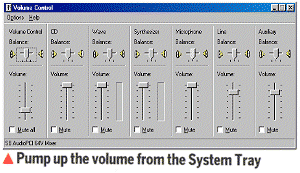 Q. I have
lost some of my sounds - those in Windows that signify events such as starting
up or making a mistake. Some of my games don't have any sounds,
either.
Q. I have
lost some of my sounds - those in Windows that signify events such as starting
up or making a mistake. Some of my games don't have any sounds,
either.
A. If you look to the bottom
right-hand corner of your screen, your Taskbar should include a selection
of icons in what Windows calls your System Tray. One of the
icons should look a little like a loudspeaker
- double-click on this and it will bring up your Volume Control window.
From here, you can check that all your volume levels are happy. Check that
none of the levels have been muted (usually a tick at the bottom of the window).
Also check that the levels are all high enough - if you can't hear Windows
sounds, make sure the bar on the Wave Out option is pushed right up to the
top to give maximum volume.
Finding out how much space is left
on a hard disk
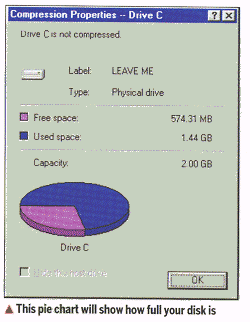 Q. Where do I look to find how much space
I have left on my 1.5Gb hard disk? People say I don't need to worry because
it's quite big and it's likely that I have used less than 500Mb, but this
is guesswork.
Q. Where do I look to find how much space
I have left on my 1.5Gb hard disk? People say I don't need to worry because
it's quite big and it's likely that I have used less than 500Mb, but this
is guesswork.
A. You are right to be
concerned, and you should always keep an eye on how much space you have left.
You may find that you have less than you think.
There is an easy way to find out this information. Click on your Start button,
and select Programs, Accessories, System Tools then Drive Space.
Double-click on the letter representing the drive you want to examine, which
is likely to be C: if you're looking at your main hard disk, and the pink
part of the pie chart will represent the amount of free space you have. You
can perform the same check on any of your drives, even removable floppy
disks.
Removing unwanted applications
Q. Having removed many old programs, games and demos
from my computer, I find legacies of their presence remain. When I use the
Add/Remove Programs facility in the Control Panel, I still have the option
to remove things I deleted long ago yet I cannot remove these options as
their unin stall files have been deleted.
A. This is one of those
idiosyncrasies that plague PCs. More often than not, especially with games,
an uninstall will not perform completely, because extra files have been added
to the program's folder, such as saved games or other bits of data that were
not originally installed.
If you know where you installed a program, it is a safe bet that you can
eliminate this folder. It's always a good idea, when installing in the first
place, to place the program in a directory (folder) with a name and location
you can remember. The suggested option often hides files down a complicated
tree-like sub-directory somewhere beyond your Program Files folder.
When deleting a directory, delete it to the Recycle Bin and leave it there
a while. This ensures that you can then reinstate it at a later date should
your computer start behaving abnormally. It's possible that the program may
have left files all over the place- especially in your Windows directory
- but we don't suggest you delete files from there because they may be used
by some other programs.
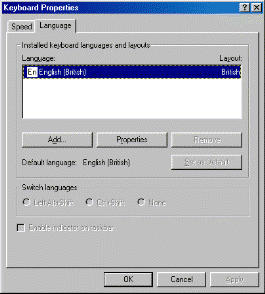 Q. When I use my keyboard,
certain keystrokes do not correspond with the characters displayed on the
screen. For example, pressing the £ key prints *, and speech marks print
as the @ symbol. I suspect my keyboard settings are in some I way incorrect.
How do I change them?
Q. When I use my keyboard,
certain keystrokes do not correspond with the characters displayed on the
screen. For example, pressing the £ key prints *, and speech marks print
as the @ symbol. I suspect my keyboard settings are in some I way incorrect.
How do I change them?
A. There are two areas where
you might be having trouble with your keyboard, so you'll need to check both.
They are both accessed from the Control Panel, so click on your Start
button, select Settings then Control Panel. First double-click on
the Keyboard icon. Click on the Language tab and make sure the language is
set to English (British) and change it if necessary. Go back to the Control
Panel and click on Regional Settings. Again, make sure English (British)
or English (United Kingdom) is selected.
Automatically arranging icons
Q. I recent]y had some problems with my PC and, after
contacting the helpline, I was informed I could only cure the problem by
reformatting my hard disk. I did this and installed everything once again
and it now appears to be working fine. However, since doing the reinstall,
the icons for My Computer and the Recycle Bin can be moved around my desktop,
whereas before no matter where you dragged them they always returned to their
original location. Is there a way I can make them return to their usual spot?
I am worried I may do something silly and delete them.
A. If you set your icons
to Auto Arrange, there shouldn't be any problem with keeping them in place.
Right-click on an empty part of your desktop and choose Arrange Icons then
Auto Arrange. When you next try to move them, they should pop back into
place.
Having said this, both these icons are difficult to delete, so with a bit
of care you shouldn't run into too much trouble.
Setting the default printer
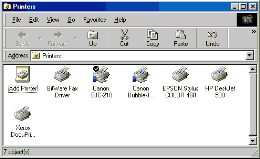 Q. I hope you can help with a problem I'm
having. Every time I try to print a document using Microsoft Works, the Compose
New Fax wizard pops up. This all started last week when I tried to send a
fax and it refused to go.
Q. I hope you can help with a problem I'm
having. Every time I try to print a document using Microsoft Works, the Compose
New Fax wizard pops up. This all started last week when I tried to send a
fax and it refused to go.
A. Double-click on the My Computer icon on your desktop,
then double-click on the Printers icon. You'll probably find that there's
a white tick on a black background looming over the icon labelled Microsoft
Fax. Right-click on your regular printer then click on Set As Default.
This will move the tick to your regular printer, which should now be the
first one Windows chooses when you have to print something out.
The Network Neighbourhood
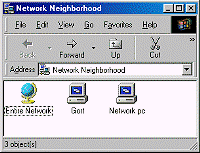 Q. While trying to solve a problem using
a telephone helpime, I started up Network Neighbourhood. It was empty, so
I tried to drop it into the Recycle Bin with no success. What's it
for?
Q. While trying to solve a problem using
a telephone helpime, I started up Network Neighbourhood. It was empty, so
I tried to drop it into the Recycle Bin with no success. What's it
for?
A. This is a section of your system that's reserved for keeping
track of other machines on any network you might have. Since you haven't
got a network, this is somewhat superfluous, and so it remains empty. However.
Windows won't let you delete it, just in case you ever need to attach another
PC in the future - no matter how unlikely that may seem at the moment.
Making Caps Lock beep
Q.I have been
using my computer
for eight months now, but I frequently find myself typing in capital letters,
having inadvertently pressed the Caps Lock key. Is there any way to make
my PC beep when I hit this key, in order to warn me that it has
happened?
A. There is a way
to make it beep. From the Start menu, select Settings and
Control Panel. Double-click Accessibility Options and tick
the bottom item, labelled ToggleKeys. This will produce a beep whenever
you hit Caps Lock, Num Lock or Scroll Lock.
Deleting from the Documents menu
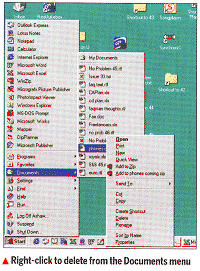 Q. When I click on Documents in the
Start menu I find a few things that I would like to delete. However, when
I go to the Add/Remove Programs in the Control Panel, none of these items
are there. Where are they, and how do I banish them from my screen?
Q. When I click on Documents in the
Start menu I find a few things that I would like to delete. However, when
I go to the Add/Remove Programs in the Control Panel, none of these items
are there. Where are they, and how do I banish them from my screen?
A. This is a list
of shortcuts to recently used files. Usually this keeps shortcuts for about
10 files in an easy-to-find list, so that if you've been using a certain
word processor file recently, you could find the file on this list rather
than searching for it on your hard disk.
To eliminate a file from the list simply right-click on it and choose Delete
from the menu. You can also clear t
 he
list completely by going to Settings on your Start menu then choosing
the Taskbar and Start Menu option. From here, click on the
tab at the top labelled Start Menu Programs and click on the button
marked Clear. When you next return to the Documents menu, you will find it
has no files in it, though it will start to fill up again as you create and
edit more files. To delete the files directly, you will have to go to the
place where they are saved. Even deleting these may mean that the shortcut
to the file stays in the Documents menu though, until it is replaced by a
more recently used file.
he
list completely by going to Settings on your Start menu then choosing
the Taskbar and Start Menu option. From here, click on the
tab at the top labelled Start Menu Programs and click on the button
marked Clear. When you next return to the Documents menu, you will find it
has no files in it, though it will start to fill up again as you create and
edit more files. To delete the files directly, you will have to go to the
place where they are saved. Even deleting these may mean that the shortcut
to the file stays in the Documents menu though, until it is replaced by a
more recently used file.
Printing font samples
Q. I would like to get a sample print of all
the fonts on my PC, but other than copying lines of text and then changing
the font on each line, I cannot see how to do it. Do you have any
ideas?
A. If you go to the
Windows directory then the Fonts directory, you should see all the fonts
on your computer. By right-clicking on a font and selecting Open, you should
be presented with information about each one, and a demonstration of how
they look in different sizes. This can be printed off as a reference.
Where to find the euro
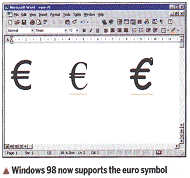 Q. Whether we like it or not many of
us are dealing with the unit of currency for the European Union, the euro.
How do I make or where do I find a resizable symbol for the euro? It isn't
in the character map.
Q. Whether we like it or not many of
us are dealing with the unit of currency for the European Union, the euro.
How do I make or where do I find a resizable symbol for the euro? It isn't
in the character map.
A. Windows 98 already has support for the euro, which you
can access by holding down AltGr (on the right of your spacebar) and hitting
the 4 button at the top of the keyboard. Any Windows 95 user who finds this
key combination doesn't work, can go to www.microsoft.com/windows/euro.asp
to download the euro-enabled version of the operating system. Most hardware
manufacturers are now shipping keyboards with the euro symbol printed alongside
the 4 key, but we recommend that you double-check this before you consider
buying a replacement.
Moving the Quick Launch bar
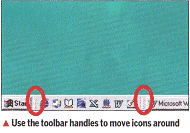 Q.
When I installed Windows 98 it loaded icons for Internet
Explorer and Outlook Express on the toolbar on the left-hand side near the
Start button. I turned this off initially, then decided I rather liked it
there, so I right-clicked on the bar and selected Quick Launch from the Toolbar
option. This did return the icons, but now they are on the right-hand side
of the toolbar. I have, to date, been unable to persuade the icons to move
over to the left-hand side.
Q.
When I installed Windows 98 it loaded icons for Internet
Explorer and Outlook Express on the toolbar on the left-hand side near the
Start button. I turned this off initially, then decided I rather liked it
there, so I right-clicked on the bar and selected Quick Launch from the Toolbar
option. This did return the icons, but now they are on the right-hand side
of the toolbar. I have, to date, been unable to persuade the icons to move
over to the left-hand side.
A. To the left of the buttons
there should be a handle - a little vertical line. Use your mouse to grab
this handle, hold the left mouse button down as you do it and drag it across
to the left. The icons should move to the left-hand side and stay there.
Clicking buttons that aren't visible
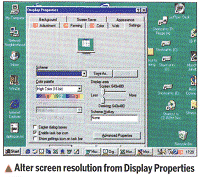 Q. Is there an easy way to access the OK or
Apply buttons in Display Properties if you accidentally accept too low a
resolution? I can't set the screen size I require as I can't get to this
button by pushing the window up far enough, as the blue line at the top of
the window goes out of the picture.
Q. Is there an easy way to access the OK or
Apply buttons in Display Properties if you accidentally accept too low a
resolution? I can't set the screen size I require as I can't get to this
button by pushing the window up far enough, as the blue line at the top of
the window goes out of the picture.
A. Right-click on your desktop
to bring the settings up and click the Settings tab. Now change your screen
resolution setting, then press Enter. The screen should change to the new
resolution without having to use the OK button.
Installing WinZip
Q. I foolishly erased the WinZip program that came with
my PC. I now realise that
WinZip is a very useful
application and would like to reinstall it. I can't find it on the Windows
CD-ROM - where can I get it?
A. WinZip isn't available
on the Windows disc and must have been put on your PC by your manufacturer.
However, you can download a trial version directly from
www.winzip.com or get it from the cover
CD of our sister magazine What PC? WinZip creates zip files, which
can be used to group and
compress a number of different
files into one. This makes it ideal for archiving your work and sending
files via email over the internet, since the space taken up can be dramatically
reduced.
Clearing the Temporary folder
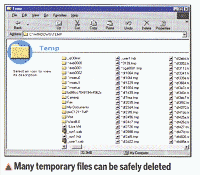 Q. I have 203 objects in my Temporary folder.
Can I delete all the files without affecting my PC?
Q. I have 203 objects in my Temporary folder.
Can I delete all the files without affecting my PC?
A. Generally, anything in
your Temporary folder is there because an application is using the space
as temporary storage. Having said that, when applications crash, they will
leave their temporary files behind because they haven't been shut down
properly.
You can find out whether any of them are needed in one of two ways. The easiest
is to delete all the files into your Recycle Bin just after starting your
PC and before launching any applications, then run your PC normally for a
good while - a couple of weeks of normal usage should be sufficient. If nothing
untoward happens and your applications don't bring up 'Unable to find file'
messages, you should be fine. The other way is to open the folder, usually
found in the C:\WINDOWS\TEMP directory and select Details from the View menu.
The date under the Modified heading shows you when the file was last used.
If this was a long time ago, it's a safe bet that you can delete the file,
though it's still worth leaving it in your Recycle Bin for a while.
Associating files to applications
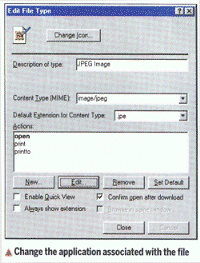 Q. I have just uninstalled
Corel Draw because
I prefer
Paint
Shop Pro for images and scanning. Now, when I go to explorer, my .jpg
and .bmp files have 'Corel Draw image' as their description, not Paint Shop
Pro. If I double-click to load a picture file from Explorer, a screen comes
up asking me to locate Corel Draw. How do I make it look for Paint Shop Pro
instead?
Q. I have just uninstalled
Corel Draw because
I prefer
Paint
Shop Pro for images and scanning. Now, when I go to explorer, my .jpg
and .bmp files have 'Corel Draw image' as their description, not Paint Shop
Pro. If I double-click to load a picture file from Explorer, a screen comes
up asking me to locate Corel Draw. How do I make it look for Paint Shop Pro
instead?
A . These 'associations'
are a feature of Windows and not individual applications. As a result,
uninstalling a package will not change a file type's association back to
an existing program, causing the PC to prompt you for the location of the
deleted one. You can change these yourself though. Select the Start button,
choose Settings then Folder Options. There will be a tab in the next window
called File Types. Choose this then scroll down the list until you find the
one you want to change. Highlight with a single click and choose the Edit
button. On the next screen, choose Edit. You get a Window with a box saying
'Application used to perform action:' above it, and a Browse button next
to that. Hit Browse and find the directory where the new application is,
in this case, Paint Shop Pro. Click on the icon for the application, press
OK on all the other screens, and next time you double- click on an icon of
its type, the new application will launch.
Renaming extensions
Q. How do I change a file's extension type in Windows
95 and 98? In Windows 3.1 this could be carried out through the Rename function
in File Manager. Renaming now appears to only allow the file name to be
changed.
A. We suspect you've got
your file extensions turned off. Open Windows Explorer and choose Folder
Options from the View menu. From the Options screen, make sure that the box
next to the words 'Hide MS-DOS file extensions for file types' that are
registered' (Windows 95) or 'Hide file extensions for known file types' (Windows
98) does not have a tick in it. If it does, click once on the box to remove
it. Next, click on OK, and when you return to Windows Explorer you should
find file extensions alongside every file. Go to your file, click on it once
and edit the letters of the extension, which should now appear after the
file name.
 SOFTWARE
SOFTWARE
Removing words from Word's dictionary
Q. While I was spell checking a document in Word 97,I
hit Add instead of Replace. Now I have incorrectly spelt words as part of
my spell checker. How do I remove them?
A. In the Tools menu select
Options. Click on Spelling & Grammar, then Dictionaries. Highlight your
dictionary (most likely it'll be called custom.dic) and hit Edit. This opens
a Word document listing words you've added to your spell checker. Delete
the offending entry, save and exit.
Creating headers and footers
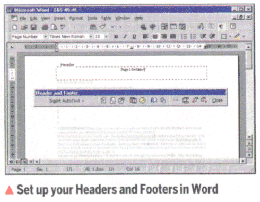 Q. When using Word 97, please can you tell
me how to set up a header or footer with both the page and section numbers
in it, so it says 'Pages section 4, for example?
Q. When using Word 97, please can you tell
me how to set up a header or footer with both the page and section numbers
in it, so it says 'Pages section 4, for example?
A. In the View menu choose
Headers and Footers and move to wherever you want to place the information.
Type the text as you would like it to appear, using the letter x or a character
of your choice to represent the numbers you want Word to replace. In your
case, it should look something like 'Page x section x'. It's a good idea
to perform any formatting (such as centring or justifying) at this stage,
so you don't have to worry about it later. Highlight the number you want
to replace, and choose Field from the Insert menu, which will bring up the
field box. Select All in the box on the left, and scroll through the box
on the right until you find the description of the number you want to replace
the 'x' with. In this case, replace the first 'x' with Page, and the second
with Section. When you return to Word, you should notice that the first page
now reads 'Page 1 section 1', and subsequent pages and sections are numbered
properly.
Unusual characters
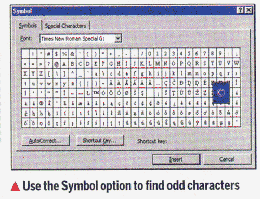 Q. I use Windows 95 to do a lot of typing
work but I do not seem to have a Character Map, or at least I cannot find
it.
Q. I use Windows 95 to do a lot of typing
work but I do not seem to have a Character Map, or at least I cannot find
it.
A. Most of the popular word
processors have this function built in now, since all fonts include special
symbols like the © symbol or accents over letters. In the case of Microsoft
Word, for example, simply go to the Insert menu and choose Symbol. Select
the Special Character tab at the top of the window and scroll down to the
character you require. This will also tell you what the hot key combination
is, which in the case of the copyright symbol is pressing C with the Alt
and Ctrl keys held down.
Word file sizes
Q. Some of my Word document files have expanded to such
an extraordinary degree that I can no longer fit them on a floppy disk, yet
there is no more text than in other files which fit on a floppy with oodles
of room to spare. What's going on?
A. When Fast Save in the
Save As options is enabled, Word 97 saves the changes you make in a document,
rather than the document itself. Because it retains all deletions and formatting
changes, it means that every time the file is saved, it increases in size.
You can disable Fast Save through Options on the Tools menu. Choose the Save
tab and make sure Fast Save does not have a tick next to it.
Also select the File menu and find the option labelled Versions immediately
below 'Save/Save As'. This facility saves successive versions of any file
you edit, in effect giving you the opportunity to return to an earlier version
if you are unhappy with your changes. Click on the Versions option to open
the dialogue box. If the 'Automatic Save Version On Close' box is checked,
then click on it to remove the tick.
Margins in Works
Q. Is it possible to permanently change the default
margins in Microsoft Works? This would save me going into Page Setup every
time I create a new document.
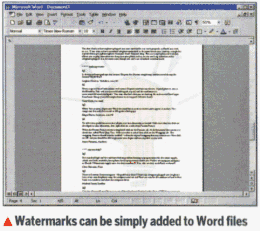 A. Open up a brand-new blank page and set the
margins as you want them in the normal way. When you are happy with these,
choose Save As from the File menu and click on the
Template button in the bottom right-hand corner. This takes you to
a new Window. Type in the name of the template, such as My Margins and tick
the box that asks whether you want to 'Use this template' for new word processor
documents. Next time you start the word processor option with a new page,
it should have the correct margins.
A. Open up a brand-new blank page and set the
margins as you want them in the normal way. When you are happy with these,
choose Save As from the File menu and click on the
Template button in the bottom right-hand corner. This takes you to
a new Window. Type in the name of the template, such as My Margins and tick
the box that asks whether you want to 'Use this template' for new word processor
documents. Next time you start the word processor option with a new page,
it should have the correct margins.
Watermarks in Word
Q. How do I get a watermark effect in Microsoft
Word?
A. Go to New in the File
menu, make sure that the Create New box is set to Template and hit OK. Select
Header and Footer from the View menu. Choose Picture from the Insert menu
and find the image you want to use from the browser. Click once on the picture
to select it and choose Watermark from the Image Control button in the Picture
toolbar to remove the colour. Drag the little squares on the edge of the
picture to resize it, and move the picture to the desired location on the
page by dragging it (holding down the left mouse button as you move around).
Right-click on the picture, select Format Picture and click on the Wrapping
tab. Select None from the available options and you're there. Save the template
via the File menu. When you go to create a new document from the File menu,
choose your watermarked template rather than the normal one.
Freezing Excel cells
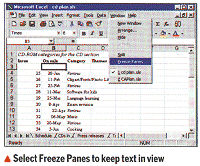 Q. I
use Excel 97. Details entered in a worksheet are listed according to the
category, which appear across the top row. When I roll down to the next page,
the categories disappear. How can I keep them at the top?
Q. I
use Excel 97. Details entered in a worksheet are listed according to the
category, which appear across the top row. When I roll down to the next page,
the categories disappear. How can I keep them at the top?
A. There are two ways you
can achieve this. If the categories you want to keep visible all the time
are in Row 1, highlight Row 2 on your worksheet. From the Window menu at
the top of your screen, select Freeze Panes. This will cause all the rows
above the highlighted row to stick in place. This works for columns too.
Alternatively, you can split the worksheet into panes. There are two scrolling
bars on your screen. Clicking on the little bar above the upwards pointing
arrow will cause a bar the length of your worksheet to appear. You can drag
this bar down as far as you like - in your case, take it down to just under
Row 1. You can scroll up and down inside your own worksheet, while the duplicate
worksheet remains static, allowing you to keep Row 1 visible at all times.
Any work done in the original worksheet will be repeated in the duplicate
worksheet.
To keep Column A in sight, do the same thing with the little bar that appears
at the very right of the scrolling bar across the bottom of your screen.
To get rid of a pane, double-click on the bar.
Unusual numbers in Excel
Q. When I use Excel and type in measurements in stones
and pounds such as 9-12 the entry appears as 9 December. How do I get my
computer to just stick to 9-12 and not change the amounts to dates?
A. It's annoying when your
computer tries to guess what you're doing and gets it wrong. This feature
is handy if you're inputting a lot of dates, but it's not at all useful in
your case and you need to create a new style.
Open the problem worksheet and highlight the whole thing by clicking in the
cell in the top left-hand corner. Go to the Format menu and select Style.
When the Style dialogue box opens, you will see that Normal is highlighted
in the Style Name box. Just start typing in - you don't need to worry that
the Normal style will still be available in the drop-down menu. Let's call
your new style Weights. Type the name, and click on Add. Now click on the
Modify tab, and make sure that the Number tab is to the front. Change the
number format from General to Text, and hit OK, then just hit OK again.
If you only want to do this to selected cells and not to the whole of your
worksheet, you can. Simply highlight the problem cells, and follow the same
steps. If you want this to be applied to all your new worksheets as default,
then make the changes to the Normal style, but make sure that you make a
note of the amendments you make in case you want to revert to your original
settings.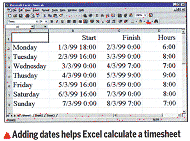
Creating timesheets in Excel
Q.I have to work both
days and nights, and must submit my own timesheets. I cannot get Excel to
work out how many hours I've worked when I've been working overnight.
A. If you include the date
as well as the time in the cells on your spreadsheet, this will help the
software work out that the hours start on one day and finish on the next.
![]()
Removing the Office Assistant
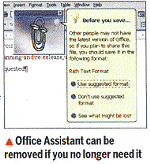 Q. I can see that the Microsoft Assistant
can be fun and useful if you are learning Microsoft Office, but as a more
experienced user I find it irritating. Is there a way of removing this little
helper once and for all?
Q. I can see that the Microsoft Assistant
can be fun and useful if you are learning Microsoft Office, but as a more
experienced user I find it irritating. Is there a way of removing this little
helper once and for all?
A. The Office Assistant
is a component of the software just like the spell checker or templates.
So toget rid of your friendly companion, orto install it if you don't already
have it, you must return to your installation CD-ROM. From the initial screen,
choose the application you wish to remove the Assistant from, then select
Add/Remove Components from the next screen. You should be confronted with
tick boxes showing lots of different features of Office. The box to the left
of Office Assistant has a tick in it. Click on the box to remove the tick
and press Continue. When you reload your application, you shouldn't be bothered
by it.
Explaining .thm files
Q. Since installing my scanner there are .thm files
littering the folder where I keep my scanned images. When I try to open these
I get an Open With dialogue box showing a list of programs. Is there any
way to open these files and what
exactly is their purpose?
A. The .thm extension is
often used when the tile is a thumbnail. This is a reduced size version of
a picture which is used to preview it when browsing through folders with
a lot of pictures in them, since it is a lot quicker to bring up a tiny
representation than the full image.
However, the only way you can see these pictures is to look at them in
conjunction with the program that made them. You still won't be able to open
them directly, as they will simply appear when you look in the folders that
hold the pictures they represent. If there's a particular reason why you
want a thumbnail-sized image, perhaps to create a button on a web page, then
you will have to make one by shrinking the image itself in an image-editing
application.
 INTERNET
INTERNET
Reducing image sizes for email
Q. I would like to attach some pictures of my children
to send to relatives via email. However, no matter what resolution I scan
a picture at, the file is always roughly 2,500Kb. Please could you tell me
how to reduce the file size?
A. The best way to
compress the size
of a picture is to save it in a
compressed format. The best format
to use is JPEG or .jpg
(try Save As in your graphics package once you've scanned an image). This
can degrade the image quality, but will also squeeze it down to a more manageable
size. Alternatively, you can use the program WinZip to squash files, and
collect them into one convenient package for sending via email. Go to
www.winzip.com to download a trial version
of it, and make sure the people you are sending pictures to also have a
copy.
Draft folder in Outlook Express
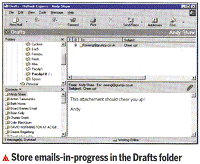 Q. Could you please explain the purpose
of the Drafts folder in Outlook Express?
Q. Could you please explain the purpose
of the Drafts folder in Outlook Express?
A. If you are writing a
message and have to leave it to do something else, you can use the Save option
in the File Menu to save the file in the Drafts Folder. Later, when you wish
to continue writing the message, move to the Drafts folder by clicking on
its icon and double-click on the email to bring the file into its own editable
window. Once you've finished, just send it and it will be deleted from the
Drafts folder.
Also, if you are reading a message in the Inbox and you want to use part
of it in your reply, then highlight the required lines and drag and drop
them into the Drafts folder. A new message window will be opened with the
selected lines printed out.
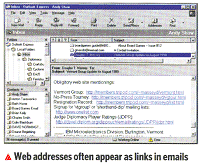
Linking to websites from emails
Q. Is it possible to put links to websites in
emails?
A. Yes it is. If you're
using Microsoft or Netscape mail programs, which are the two most common,
simply type the web address into your mail. If the recipient is also using
one of these packages, the web address will appear blue and underlined, and
when clicked on will launch a web browser and go directly to the site. Otherwise,
just type the link into your email as normal and instruct the recipient to
highlight it, choose copy from the Edit menu and Paste it into the Address
box of their web browser.
Composing email without logging on
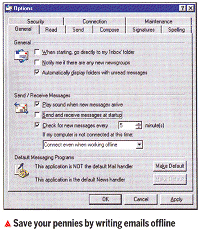 Q. My
email is sent and received using
Outlook Express.
Currently, I have to be online to use it. How do I set it up so I can work
offline to compose my email, only going online when I choose to and not by
default?
Q. My
email is sent and received using
Outlook Express.
Currently, I have to be online to use it. How do I set it up so I can work
offline to compose my email, only going online when I choose to and not by
default?
A. Click on the Tools menu
and select Options. Choose the General tab and you should get a box with
a tick next to 'Send and receive messages at startup'. Click on the tick
to remove it and Outlook will never go online without your permission.
Checking you can receive email
Q. I have just signed up with Freeserve, the internet
service provider. I think I have mastered sending emails but I'm not sure
about receiving them. How can I check I'm doing everything right?
A. The best way to see if
your email program is receiving emails is to send one to yourself.
Logging out of Outlook Express
Q. I am using Windows 95 and am having trouble with
an intrusive Enter Windows Password box. I follow the instructions by not
entering a password and clicking OK, which ought to ensure that I don't see
this prompt again, but it doesn't work. The box appears each time I choose
to log off after a spell on the internet, and at no other time.
A. The Log Off option in
Outlook Express version 4 actually logs you off Windows and not just the
internet. By selecting this option, Windows assumes that you are leaving
your PC and want to secure it so that other users can't change your personal
settings.
If you want to stay in Windows but disconnect your modem from the internet,
right-click on the icon resembling two linked computers in the System
Tray in the bottom right-hand corner of your screen. This will close
down the link from the modem but won't shut down any of the software you're
using.
Line breaks in emails
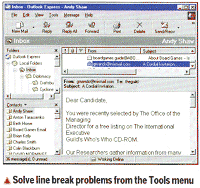 Q. When I compose an email in Outlook
Express it looks fine. The lines break in the right place, at the end of
the line, unless I use the Enter key to finish them earlier. When I select
Send the message goes to the Outbox, and if I look at the message there it
is all broken up. I am told that my friends also receive my email in this
same state.
Q. When I compose an email in Outlook
Express it looks fine. The lines break in the right place, at the end of
the line, unless I use the Enter key to finish them earlier. When I select
Send the message goes to the Outbox, and if I look at the message there it
is all broken up. I am told that my friends also receive my email in this
same state.
A. When you send email,
the package you use may automatically start new lines after a certain number
of characters, in case the recipient doesn't have an email browser that does
it automatically.
However, most email packages will break up the incoming text automatically
if one of these lines extends beyond the display window.
You can change the distance at which the text is broken up by selecting
Options from the Tools menu. Click on the Send tab and
on the Mail Sending Format: Plain Text Settings button. It's best
to send all your mail in plain text since this makes it more likely that
everyone will receive it in the same way as it has been sent. In the box
next to 'Automatically Wrap Text At' reduce the number of characters to prevent
your lines from spilling over.
Blocking email
Q. Is it possible to block emails carrying attachments
using Outlook Express? If so, how is it done? This would surely cut down
the risk of receiving junk and contaminated emails.
A. It is possible to block
these from coming through, though it will not discriminate between junk and
friendly emails. If you do want to eliminate them all, make sure your contacts
know never to send you any attachments, or their emails will be lost. Choose
Message Rules from the Tools menu and select Mail. This
allows you to create filters for your mail. Select New and in the
first window click in the box next to Where The Message Has An
Attachment, in the second window click in the box next to Delete It
From Server and click on OK.
As soon as Outlook Express next comes across a file with an attachment, it
will delete it as soon as it arrives in your email program.
Stopping Outlook from popping up the
dial-up box
Q. When using Outlook Express I get the dial-up connection
box appearing on my screen at random and I then have to retype my password.
It all takes time and if I am in full flow on the keyboard it can go unnoticed
until I look up at the screen. The only way I can overcome this is to go
online and type my emails, but this can be expensive in call charges. All
I want to do is type an email, go online to send it and then disconnect.
A. We suspect that there
is a problem with the way you have Outlook Express set up. From the Tools
menu choose Options and click on the General tab. Make
sure that the tick boxes next to 'Send and receive messages at startup' and
Check for new messages every do not have ticks next to them. This should
stop your dial-up box from appearing without you asking for it.
Sorting mail into users' mailboxes
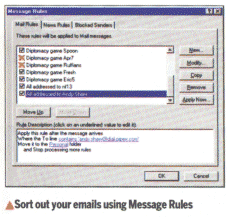 Q. I have recently installed Internet Explorer
5, which comes with the latest version of Outlook Express. Could you tell
me how to receive email addressed to other members of the family into their
own folders? I have already set the email accounts up but they don't
automatically go into their own folders.
Q. I have recently installed Internet Explorer
5, which comes with the latest version of Outlook Express. Could you tell
me how to receive email addressed to other members of the family into their
own folders? I have already set the email accounts up but they don't
automatically go into their own folders.
A. From the Tools
menu of Outlook Express select Message Rules then Mail. These
are a set of rules that you can pass your emails through to sort them into
separate folders. Click on the New button to create a new rule. In
box one click on the option 'Where the From line contains people', then click
on the underlined 'contains people' phrase that should appear and enter the
email address you want to sort in the box. Click on Add and then OK.
Move down to the box labelled 'Select the Actions for your rule' and click
on 'Move it to the specified folder' (which you must then specify as you
did the email address) and also select 'Stop processing more rules'. Name
your rule in the final box and click on OK.
Repeat this process for any other email addresses you might have coming in,
and you should find that everyone's mail is sorted to their new
folders.
Transferring email archives
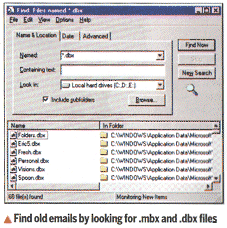 Q. I have recently bought a new PC. Can you tell
me how to copy all of my old emails across from my old PC?
Q. I have recently bought a new PC. Can you tell
me how to copy all of my old emails across from my old PC?
A. Email folders used by
Outlook Express have a .dbx, .mbx or .idx suffix. You can search for these
on your hard disk by using the Find option from the Start menu and
typing *.dbx, etc in the 'Named:' box, making sure that the 'Look In:' box
has been set to the whole drive and copy these files to a backup disk.
Or you can back up all of your email and newsgroup information in one go.
Just copy the files in the Outlook Express folder, which can be found in
C:\Windows\Application Data\M icrosoft\ Outlook Express.
Including the last message in a new reply
Q. When someone responds to one of my email messages,
they always have my previous message included in the email so that I can
refer back to what we have been talking about. When I send an email back
to them, their previous message does not appear. How can I make Internet
Explorer do this for me?
A. Select Options from
the Tools menu. Click on the Send tab and make sure there is
a tick in the box
to the left of Include message in reply'. The email history will now be included
in the message.
![]()
What www and http:// mean
Q. Many web addresses start 'www.', which I presume
to mean world wide web. But I notice that some have 'http://' at the beginning.
Why is this?
A. The http stands for
hypertext transfer protocol. Hypertext is the system used to build
web pages, and isn't actually as complicated as it sounds. The transfer protocol
bit is a posh way of saying that this uses a standard way of sending the
web pages to your PC, so that incompatible machines (like PCs and Apples)
can see the same web pages.
The http part of a web address essentially warns your browser that it is
going to receive a web page, just as a www prefix does. Not all web page
addresses start with www, but all start with an http, so modern web browsers
don't insist that you type it in each time.
Installing a counter on a web page
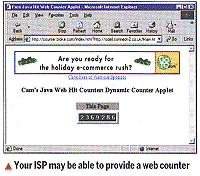 Q. I am almost finished designing
my first web page and would
like some help adding a counter to the page so I can see how many people,
if any, actually visit my site.
Q. I am almost finished designing
my first web page and would
like some help adding a counter to the page so I can see how many people,
if any, actually visit my site.
A. First you need to make sure that your ISP can support a counter.
If it can, chances are that it will already have a counter set up that you
can use.
If you use free web space or your ISP doesn't provide this facility, a list
of free counters and information on using them can be found at
www.markwelch.com/
bannerad/baf_counter.htm.
Making a web page your start page
Q. I have recently setup internet access on my PC and
use Freeserve as my ISP. When I start, the Freeserve page appears and I get
the Lycos search engine on the home page. I was just wondering if it would
be possible for me to change this search engine to Yahoo?
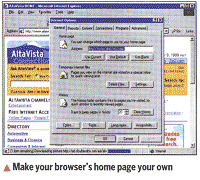 A.
You can't change what appears on the Freeserve home page, but
you can make your browser open a different page when you first start it up.
Go to the page you want to change to and select Internet Options from
the View menu. Hit the tab labelled General (if it isn't already
showing) and click on the button labelled Use Current.
A.
You can't change what appears on the Freeserve home page, but
you can make your browser open a different page when you first start it up.
Go to the page you want to change to and select Internet Options from
the View menu. Hit the tab labelled General (if it isn't already
showing) and click on the button labelled Use Current.
Q. I have a free internet provider which provides me
with free email, but it does not provide newsgroups. Is there any way I can
access all the newsgroups without changing my service provider
subscription?
A. There are ways in which
you can browse newsgroups using your web browser. One of the most comprehensive
services is DejaNews which can be found at
www.deja.com.
Country and organisation identifiers
Q. Having been on the internet for a couple of months
now, I'm intrigued to know what the difference is between a .com and a co
in a website address. The
latter always seems to be followed by a country's initials, such as .uk.
What other suffixes are there? The only other ones I've come across are org
and .gov.uk. I often try to make an educated guess at a company's website
address to avoid using a search engine, but how does one predict which suffix
to use?
A. The difference between
.com and .co.uk is the country. Web addresses ending in .com are presumed
to be American companies (but this is changing as the web grows), or at least
the website where the company would want their US customers to look for them.
The .co part of any other address also implies that it is a company, but
the other initials should tell you where the company is based. For example,
addresses ending in .jp are Japanese and .de addresses are German.
Of course, not every website is a commercial one. An address with .ac as
its suffix is an academic site, .gov is for the Government, and org is used
by organisations that don't want to be considered companies, such as
charities.
Any of these that aren't followed by country initials are presumed to be
from the US. If you want to try and guess a company's website, start off
with www.companyname.co.uk in case they have a British website, then try
www.companyname.com for a worldwide site. If this fails, it's often best
to make sure you are using the right search engine, as this reduces the chances
of having to hunt around. A directory search, such as Yahoo at
www.yahoo.co.uk, will often turn up
the best results for company searches of this nature.
Saving web pages on your hard disk
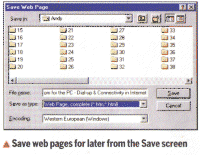 Q. To save time while online I download
any interesting material to my hard disk.
Q. To save time while online I download
any interesting material to my hard disk.
However, when doing this, any pictures or graphs are not saved. Is there
any way that these items can be downloaded and reproduced with Internet
Explorer5?
A. Internet Explorer does
let you do this. Go to the website of your choice, select Save from
the File menu and you will be presented with the standard Save window.
However, one of the options is 'Save as type' and you should make sure that
this is set to 'Web Page, complete'. Save the page and you should have everything
you need to view it offline in its entirety.
The difference between email and web
addresses
Q. I receive a regular email newsletter with links to
other internet addresses in it. I can use some of these by making a copy
of the link and using the Compose Message and Send facilities on Outlook
Express but sometimes I get the message No Matches Found. I have tried to
send them using Yahoo Mail but I just get told that part of the email address
is missing.
I have no trouble in sending emails so what is going wrong with my attempts
on these addresses which have appeared as links?
A. Unfortunately, a website
is not the same thing as an email address, so sending messages to a web page
address simply doesn't work. The addresses we receive as examples of this
kind of problem are web addresses and are used for browsing the web. Open
up Internet Explorer, the software where you found Yahoo and type the whole
line, starting with http://, into the box labelled Address near the top of
the screen, then press enter. This will take you to the web page you require.
With some of the more modern web browsers you don't have to type in the http://
part of the address, though you should experiment to find out whether this
option works with your browser or not.
Generally speaking, you can tell which addresses are web pages because they
will start with either http:// or www. If it is an email address it will
have an @ sign in the middle of it, separating the identification of the
person from the name of the organisation that provides the email service.
Take the example of Computeractive. If you want to view our web page, you
open Internet Explorer and type
www.computeractive.vnunet.com.
To email
the problem page of the magazine you type
noproblem@computeractive.co.uk.
Notice how they differ and watch out for these clues in the lists of addresses
you are sent. If you want to converse with an organisation and you know it
has a web page but don't know the email address, there will often be a
Contact Us section somewhere on the page. This will often be a link
to an email address, so you can either
Compose a new message
and copy the link to the To: section, or simply click on the link and let
Internet Explorer pull up a message window and copy the address to it
automatically.
What is ICQ?
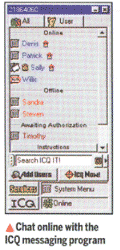 Q. I keep seeing the initials ICQ followed
by a number. I also saw contact me via ICQ on an email recently. What does
ICQ stand for and what is it all about?
Q. I keep seeing the initials ICQ followed
by a number. I also saw contact me via ICQ on an email recently. What does
ICQ stand for and what is it all about?
A. ICQ (I seek
you) is a messaging program through which you can instantly send messages
and files, as well as chat to other people who have the software and are
also online at the time.Each user has an individual number that they can
share with their friends, but you can also search for people by their name
or email address. If you have friends orcolleagues in different locations,
and spend a lot of time connected to the internet, this can be a very useful
tool for contacting them.
You can download the software for free from
www.mirabilis.com, though there are
other similar services available from Yahoo, MSN and AOL, so you have to
make sure that you and your friends all use the same service.
How to use FTP software
Q. I have just finished creating my first web page and
I have downloaded an FTP
program from the internet. What
do I do now?
A. . Moving files around
the internet is done with FTP (File Transfer
Protocol) software. If you don't have one of these, you can get one
from www.ipswitch.com free of charge. You also need to find out from your
internet service provider what the address is of the computer used to store
its subscribers' home pages - most companies will have this information on
their website.
When you load your FTP package it will show a dialogue box where you must
type the address of the computer at your internet service provider and your
usual log on details. Once you have connected to the server, the FTP package
will show two windows, one being the remote folder and the other being a
local folder. Using the techniques you would normally use to browse folders
on your PC's hard disk, look through the local folders on your hard disk
until you find the directory where you've been storing your home page. You
should notice that between the two windows are two arrows, one pointing from
the local computer to the remote computer, and the other pointing back again.
Simply highlight the files on your machine that you want to move, by clicking
on them once, click on the arrow pointing to the remote server, and the file
should appear on the remote computer, located with your provider. Repeat
this process with all of the files and graphics that make up your home page
and you should then be able to go to your web browser, tap in the location
of your web page and see it on the web in all its glory.
Making shortcuts for applications
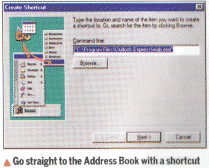 Q. In Windows 98 I have made shortcuts on
my desktop for frequently used folders. In My Documents, in the Go menu there
is an item called Address Book. Is it possible to have a shortcut for this
on the desktop?
Q. In Windows 98 I have made shortcuts on
my desktop for frequently used folders. In My Documents, in the Go menu there
is an item called Address Book. Is it possible to have a shortcut for this
on the desktop?
A. This is a shortcut in
itself, which points to the address book in Outlook Express -Microsoft Internet
Explorer's contact management system. Right-click on the point on your desktop
where you want the shortcut to be, then choose New followed by Shortcut.
In the box that comes up, type the location of the file WAB.EXE on your system.
This is most commonly located in C:\Program Files\Outlook Express\wab.exe
but if you can't find it, click on the Start button, and select Find, Files
or Folders and type in WAB.EXE to find where it's hidden. After entering
its location, click Next, give the shortcut a name, then click Finish.